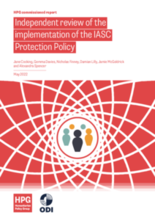Introduction
In 2016, the Inter-Agency Standing Committee (IASC) adopted a Protection Policy to reaffirm the importance of protection in humanitarian action and emphasise its significance as a collective responsibility of all humanitarian actors. Building on the adoption of the IASC Principals’ Statement on the Centrality of Protection, the IASC Protection Policy emphasised two critical departures to how protection had been approached within the humanitarian sector until that point. First, it aimed to elevate protection to a system-wide responsibility, rather than just a concern of the protection cluster. This required making the shift from protection solely as a sectoral activity to a collective responsibility of the entire humanitarian system. Second, it framed protection as an outcome that humanitarian actors should seek to achieve in terms of reducing risks to violence, coercion and deliberate deprivation (herein referred to as reducing risks) of affected populations, rather than just an activity to be undertaken. This required a shift in how risks are analysed and how interventions are designed to address them.
Six years after the adoption of the Protection Policy, the IASC Principals commissioned this review to assess implementation of the Policy in a range of humanitarian crises. Using a systems thinking approach, the review sought not only to identify the critical issues that had impacted the implementation of the Policy, but also to increase understanding of the key enablers of and barriers to progress. It also aimed to identify practices that had brought about change, and whether the right incentive structures and behaviours were being displayed to bring about change.
Findings
Six years after the IASC Protection Policy was adopted, the review found that partial progress has been made towards its implementation. However, the ambition and intent of the Policy have not been met, and there is still a significant gap between policy and practice. While there has been significant effort and investment in approaches to support implementation, they have been incoherent, inadequate and ineffective. Collective action by humanitarian actors to ensure protection is at the core of humanitarian action has not been achieved, and the aims of the Policy have not been fulfilled. For the following reasons, humanitarian actors have failed populations at risk.

